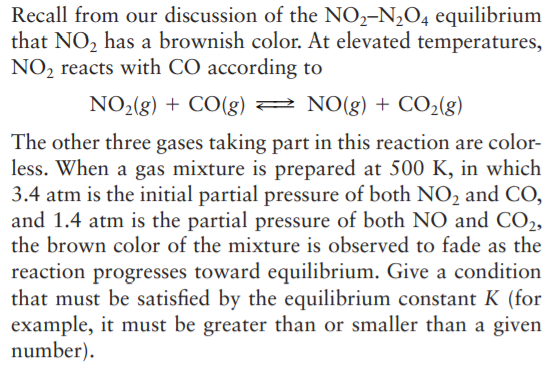Recall from our discussion of the NO,-N2O4 equilibrium that NO, has a brownish color. At elevated temperatures, NO2 reacts with CO according to NO2(g) + CO(g) 2 NO(g) + CO2(g) The other three gases taking part in this reaction are color- less. When a gas mixture is prepared at 500 K, in which 3.4 atm is the initial partial pressure of both NO, and CO, and 1.4 atm is the partial pressure of both NO and CO2, the brown color of the mixture is observed to fade as the reaction progresses toward equilibrium. Give a condition that must be satisfied by the equilibrium constant K (for example, it must be greater than or smaller than a given number).
Recall from our discussion of the NO,-N2O4 equilibrium that NO, has a brownish color. At elevated temperatures, NO2 reacts with CO according to NO2(g) + CO(g) 2 NO(g) + CO2(g) The other three gases taking part in this reaction are color- less. When a gas mixture is prepared at 500 K, in which 3.4 atm is the initial partial pressure of both NO, and CO, and 1.4 atm is the partial pressure of both NO and CO2, the brown color of the mixture is observed to fade as the reaction progresses toward equilibrium. Give a condition that must be satisfied by the equilibrium constant K (for example, it must be greater than or smaller than a given number).
Chemistry: The Molecular Science
5th Edition
ISBN:9781285199047
Author:John W. Moore, Conrad L. Stanitski
Publisher:John W. Moore, Conrad L. Stanitski
Chapter12: Chemical Equilibrium
Section: Chapter Questions
Problem 61QRT
Related questions
Question

Transcribed Image Text:Recall from our discussion of the NO,-N2O4 equilibrium
that NO, has a brownish color. At elevated temperatures,
NO2 reacts with CO according to
NO2(g) + CO(g) 2 NO(g) + CO2(g)
The other three gases taking part in this reaction are color-
less. When a gas mixture is prepared at 500 K, in which
3.4 atm is the initial partial pressure of both NO, and CO,
and 1.4 atm is the partial pressure of both NO and CO2,
the brown color of the mixture is observed to fade as the
reaction progresses toward equilibrium. Give a condition
that must be satisfied by the equilibrium constant K (for
example, it must be greater than or smaller than a given
number).
Expert Solution
This question has been solved!
Explore an expertly crafted, step-by-step solution for a thorough understanding of key concepts.
This is a popular solution!
Trending now
This is a popular solution!
Step by step
Solved in 2 steps with 4 images

Recommended textbooks for you

Chemistry: The Molecular Science
Chemistry
ISBN:
9781285199047
Author:
John W. Moore, Conrad L. Stanitski
Publisher:
Cengage Learning

Chemistry by OpenStax (2015-05-04)
Chemistry
ISBN:
9781938168390
Author:
Klaus Theopold, Richard H Langley, Paul Flowers, William R. Robinson, Mark Blaser
Publisher:
OpenStax

Chemistry for Engineering Students
Chemistry
ISBN:
9781337398909
Author:
Lawrence S. Brown, Tom Holme
Publisher:
Cengage Learning

Chemistry: The Molecular Science
Chemistry
ISBN:
9781285199047
Author:
John W. Moore, Conrad L. Stanitski
Publisher:
Cengage Learning

Chemistry by OpenStax (2015-05-04)
Chemistry
ISBN:
9781938168390
Author:
Klaus Theopold, Richard H Langley, Paul Flowers, William R. Robinson, Mark Blaser
Publisher:
OpenStax

Chemistry for Engineering Students
Chemistry
ISBN:
9781337398909
Author:
Lawrence S. Brown, Tom Holme
Publisher:
Cengage Learning

Chemistry: Principles and Reactions
Chemistry
ISBN:
9781305079373
Author:
William L. Masterton, Cecile N. Hurley
Publisher:
Cengage Learning

General Chemistry - Standalone book (MindTap Cour…
Chemistry
ISBN:
9781305580343
Author:
Steven D. Gammon, Ebbing, Darrell Ebbing, Steven D., Darrell; Gammon, Darrell Ebbing; Steven D. Gammon, Darrell D.; Gammon, Ebbing; Steven D. Gammon; Darrell
Publisher:
Cengage Learning
